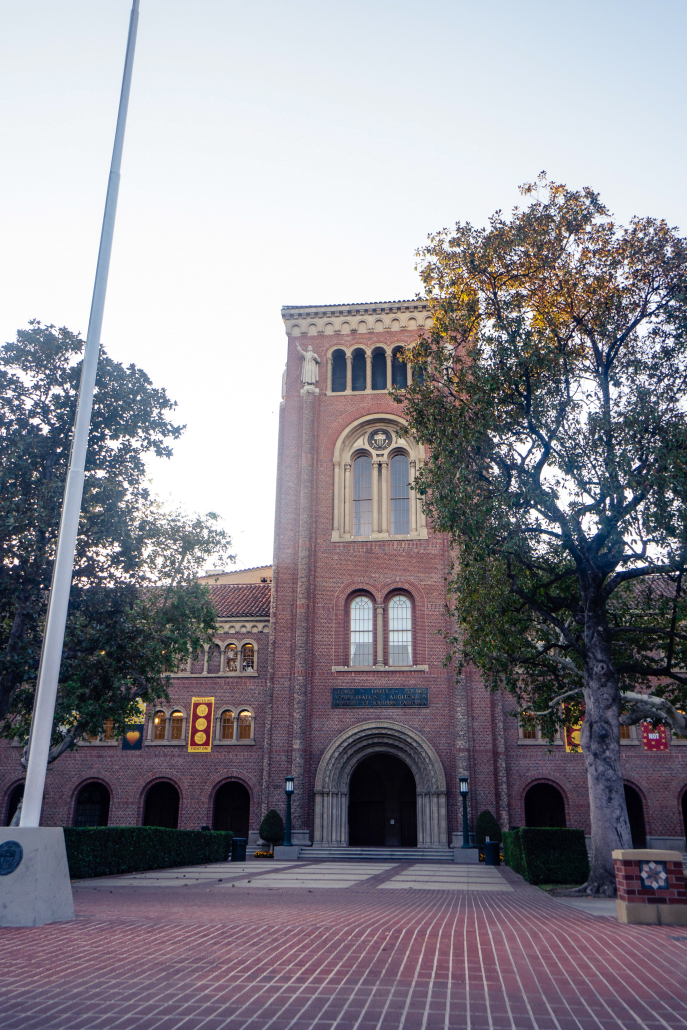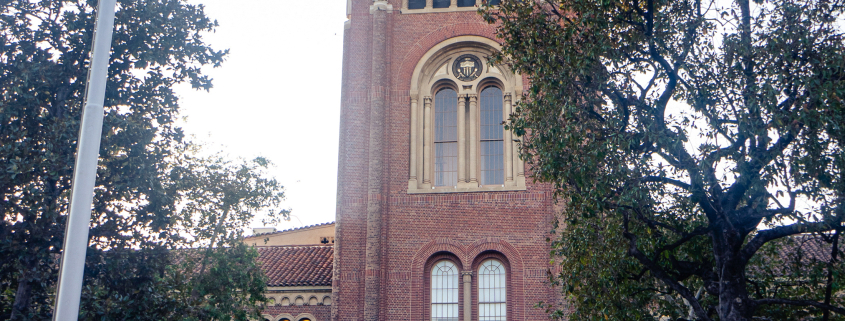Freshman class of 2025 improves from years past

Annabel Street and Celia Wood are two first-year students of contrasting backgrounds – a recurring theme that speaks to the incoming freshman class’s broader makeup.
Annabel Street, a freshman majoring in international relations, opened her admission decision at her boarding school in Maine.
“I was by myself in my room and opened up the portal – I remember being really excited, and I ran to go tell one of my friends – I was just really thrilled,” Street said.
USC’s first-year class is the most “diverse and talented” group of students ever enrolled by the University, according to the USC Office of Admission. The class of 2025 broke numerous admission-related records, following an unparalleled 70,971 applications for the Fall 2021 admissions cycle.
Of the 3,668 first-year students enrolled by the University, a record 23% are the first in their families to attend college – an increase from the 17% reported last year – and a 9% increase from 2011. A record 32% of first-year students come from historically underrepresented groups – a three-point increase from 2020. One in five first-year students identify as Latinx, and the number of Black students almost doubled to 9% – both increases from the previous year.
Despite improving diversity trends, Street said there is a lot more work to be done with increasing diversity on campus, particularly supporting low-income students.
“I think there’s a lot to be done with diversity on campus primarily in terms of how to get students who come from [different] financial backgrounds,” Street said. “And once you have students like that on campus, how can we support them and make sure that this environment is one that will do as much for them, as it does for students with more privilege.”
In addition to diversifying the University’s student body, the class of 2025 hails from a variety of regions around the country and across the world. Among the enrolled class, all 50 states and 88 different countries are represented. California is the highest represented state in the freshman class, making up 42%, followed by New York, Texas, and Illinois. New Jersey and New York. Along with geographical diversity within the United States, 13% of the first-year class identify as international students – a slight uptick from the year before. Mexico, Canada, India, China and South Korea are the most represented countries among the class of 2025’s international student population.
The class of 2025 shined as a particular standout for the admissions office, said USC Dean of Admissions Timothy Brunold in an interview with the Daily Trojan.
“A trend at USC is that each year the students just get better and better,” Brunold said. “This past year academically, the [freshman class] is absolutely more well prepared.”
Among the first-year enrolled class, more than a fourth of students received “perfect grades” in high school, with a cumulative unweighted GPA of 3.83 – a tie with last year’s class for the highest average GPA in USC history.
“We can see through the typical measures that we consider the kinds of classes that [students] engaged in high school, the curriculum they pursued, the grades they earned … just in terms of overall preparation and overall fit for the University, we felt that this was the group of students that [best] fit with what we’re trying to accomplish,” Brunold said.
Brunold said the admissions office combs through thousands of applicants and pursues those who present an inclination to help achieve the University’s main objectives.
“We’re always trying to achieve in the admission process by bringing students to the University who will help the University in its mission, its strategic objectives and most importantly, we’re looking to bring students whom the faculty want to teach,” Brunold said. “We feel like this class really checks all those boxes.”
Despite the temporary suspension of the standardized testing requirement because of the ongoing coronavirus pandemic, Brunold is “confident” that the first-year admitted class will be prepared for USC’s academic curriculum. He also said the office is reevaluating the role standardized testing plays in the admissions process and said that no permanent decision has been made on whether the requirement will be reinstated.
“You can bet what we’re going to be doing over the next year or more is we’re going to be studying [this current] cohort of students very directly – because we’re always doing validity studies of our entering classes, and we’re always trying to make sure that the students we’re bringing to the University are prepared and having the kinds of outcomes that we want,” Brunold said.
Street said she is excited to be a part of the first-year class. She credits the waived standardized testing requirement with recruiting the most talented class.
“I think by waiving SAT requirements offered a lot more ways for students to be looked at, outside of their academic statistics, and so I think what when we talk about how this class is the most talented that is because we started recognizing this year that talent comes from a lot more areas than just how well you can do on a standardized test,” Street said. “I think it’s really exciting to be in classrooms with students whose abilities and talents come from a wide range of places.”
13% of the USC freshman class are legacy students – meaning students with some kind of familial tie to the University. According to the 2020 USC common data set, admission officers consider a student’s alumni relations when reviewing an applicant’s credentials. Despite a national survey finding that seven in 10 college students feel the use of legacy admissions is “unfair,” Brunold said USC admissions officers consider legacy status to ensure Trojan families remain connected for future generations for the University.
“We’ve always felt at USC that there was value in keeping Trojan Family legacies ongoing. When we see applicants who have some connection existing to the University, we do think it’s beneficial to keep that potential alive for future generations,” Brunold said. “But that being said, the role of legacy in our admissions process is not a defining factor … While being a legacy at USC is something that we track and we pay attention to, it’s not an overwhelming, defining factor in the reasonsomeone gets admitted.”
Wood, a freshman majoring in animation and digital arts, is among the 13% of first-year students who identifies as a legacy student. One of her siblings graduated from USC and another is currently a senior at the University.
“I think it’s difficult because there is a stigma, like [some] think you don’t have to try to get in [if you’re a legacy,] and it’s difficult for the University to have a connection with their alumni while prioritizing the most adequate students for the class,” Wood said. “Having older siblings who went here helped me to know what the student body is like and to know what [the admissions office] was looking for.”
Wood said there are only 14 people in her major but has already seen the depth and diversity within the student body.
“Just looking at my major alone, these are some of the most talented kids I’ve ever met –– it definitely feels good to be a part of this class,” Wood said.

